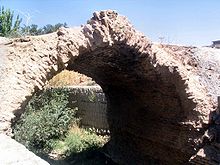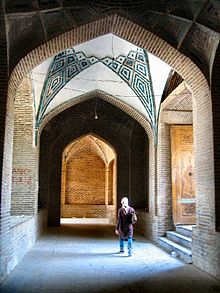Borudscherd – Wikipedia
Borudscherd (Persian Boroujerd , DMG Borūǧerd ), internationally too Boruzrd , is a city in the province of Luristan in the west of Iran. It is also the center of the district of the same name.
Borudscherd is one of the oldest surviving cities in Iran, whose region bordered at the time of the Sassanids to Hahavand. During the Seldschuken rule (9-10 centuries), the city gained importance and became a geostrategically significant trade center of the Zagros region, which it remained until the 20th century. During their flowering period in the Kajar period (18th and 19th centuries), Borudscherd became the center of Lorestan and Chuzestan. Today Borudscherd is the second largest city in the province of Lorestan and at the same time the regional center for industry, culture and tourism. The cityscape is characterized by numerous mosques, bazaars, bridges and houses that were built during the Seldschuken- und Kadschartegenzen.
The city population of Borudscherd is generally considered tolerant, and so over time, several religious minorities settled, including supporters of the Jewish faith, Sufism and Baha’i religion. The city also bears the name Daro-s-sorur, What as much as Place of happiness means. Today Borudscherd is occasionally a small Paris (Paris-e Kutschulu) designated.

Borudscherd is about 1670 m above sea level. The climate is determined by mild temperatures in summer and cold winter. The highest point is the 3623 m high Garrin-Berg, the lowest of the gelerud river south, which is at an altitude of 1400 m.
The Borudscherd administrative area extends over an area of 2600 km² with 400,000 inhabitants and, in addition to the city, also records another 180 villages.
Borudscherd is located at the Silakhore level, the largest agricultural area of Lorestan, which is enclosed from the southeast to the southwest of the mostly snow-covered Zagros Mountains. The rural population works on farms or keeps their own cattle.
The urban population works in factories, small businesses, government offices or in the army. During the summer months, many nomads gather at the foot of the Zagros Mountains, such as luries and bakhtiari, to let their cattle graze there.
Several long -distance roads run through the area. It forms a cross between Khusestan and Tehran, as well as between Esfahan and Kermānschāh.


The area around Borudscherd has been at least since the 3rd century BC. BC inhabited. Meder used the pasture land for horse breeding and horse department. The Seleucids set up a strategic military garrison in the Rumian Castle. Among the Sassanids, Borudscherd developed into a city where they built a fire temple.
In the fight against the Arab conquerors (637–651), the Iranians used Borudscherd Castle to support the troops. The last battle took place at Hahavand, 55 km northwest of Borudscherd. After the defeat, Yazdgerd III. Refuge in the castle of Borudscherd, where his army followed. The Islamic governor of Arabs Abudol Ibn Hamulah had the city built and put the Jame ‘mosque on the Zoroastrian fire temple.
Seldschukische rulers often traveled to Borudscherd and many of their fights also took place here. Berk-Yaruq, Sultan of the Großseldschuken (1094–1105), died in Borudscherd. According to some sources, Zavvarian, 5 km north of the city, is his grave, but most of the historians agree that his body was brought to Isfahan.
From approx. 1000 to 1500, Borudscherd was from the ATAbEbs of Kleinluristan ( Lur-i Kutschik ) ruled. Jingis Khan and the Mongols attacked their principality and destroyed both Borudscherd and Chorramabad. Timur also attacked the city twice and destroyed it, but the Timurids used the Borudscherd and the Rumian Castle for their military purposes.
During the Safawiden rule (1500–1700), Borudscherd was ruled as an independent area that Japlaq or Gapleh was connected to and with Golpayegan.
The Zandkönige (1750–1794) came from Loristan and came from the area around Borudscherd and Malayer.
During the Kadschar period (1779–1925) the city grew quickly and developed into the center of several administrative areas (Borudscherd, Lorestan and Khuzestan). Many buildings, including the Soltani mosque, the large bazaar, several schools and gardens were built and the city palace was rebuilt.
After Reza Schah Pahlavi (1925–1944) came to power, he had some uprisings down in Lorestan. He rebuilt the army and had the railroad, streets, hospitals and modern schools build in Borudscherd. During this time, the former Borudscherd region was dissolved and the city of the province of Lorestan was assigned.
After the 1979 revolution and during the Iran-Irak War, Borudscherd took up many injuries and refugees from the province of Khuzestan, although it was attacked several times. During an attack alone, 65 children died in a primary school. The population has increased again in recent years, but the city has suffered from social problems such as unemployment and drug abuse.
In March 2006, 66 people died in Borudscherdi-Erdbieben and 1,400 people were injured.
Historical sights [ Edit | Edit the source text ]
- Friday mosque of Borudscherd
- Solani Moschee
- Imamzade DSCha’Far
- IMAMZADE Ghasem
- IMAMZADE Ibrahim
- IMAMZade Schahzade Abol-Hasan
- Imamzade Vallian
- IMAMZADE Ghasem
- Zavvarian-Grabmal in Borudscherd
- Ghale Hatam Bridge
- Tschalantschulan bridge, Borudscherd
- Ghorogh-Brücke
- Rumian-Brücke
- Borudscherd bazaar
Many of the archaeological sites have not yet been examined.
A dialect typical of the city is spoken in Borudscherd, a mixture of Lori and the Persian standard language. You can also find other dialects such as Lori, Leki, Local Azeri, and Judäo-Persian the local Jewish language.
- The Goldascht-Valley
- The Vennaii – village
- The Tschogha-Berg
- Bishen-Dalan-pond
- Ounsarakuh, who’s whom
- The Frauenpark in Borudscherd
- Hossein Borudscherdi (1875–1961), Großajatollah
- Abdolhossein Zarinkoob, literary scholar and historian
- Loris Tscheknvorian, composer (* 1937)
- DSCHA’FAR SCHAHIDI, HISTORIKER
- Abdolmohammad Ayati, writer and poet
- Mehrdad Avesta, contemporary poet
- Allameh Bahr-Ol-Olum, religious scholar of the 19th century
- Samet Borudscherdi, poet (19th and 20th centuries)
- Ehsan Mohajer Shojaei (* 1983), athlete
Borujed, Boroujerd, Borudjred, Boroojred, Brujed, Burujird, Borugerd
-

Imamzadeh Ja’far, 11th century
-

-

Recent Comments